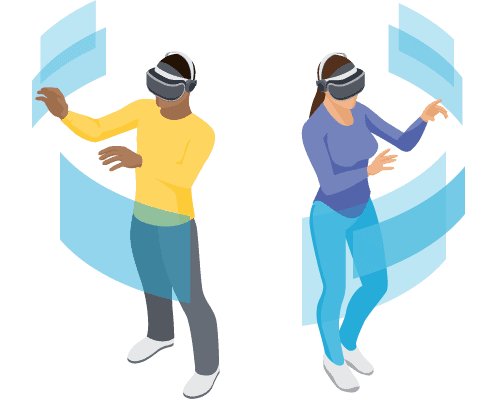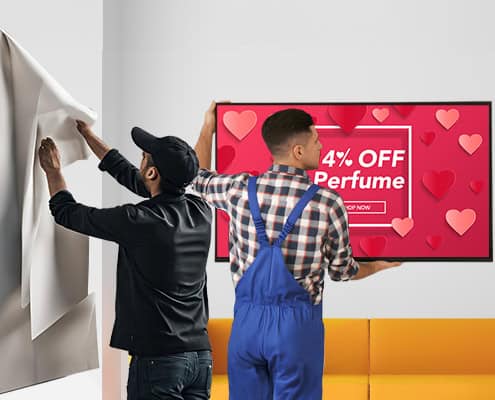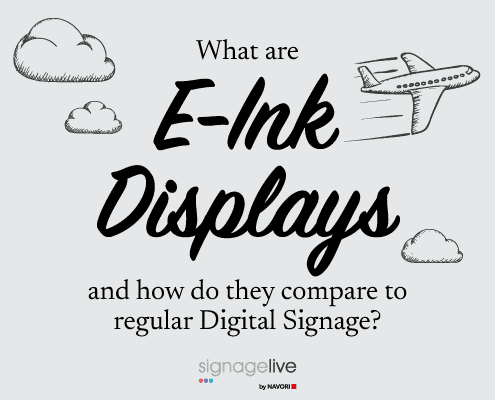In a world where digital changes quickly, how do we prepare Digital Signage for a new kind of experience?
As I write this, I’m currently transcribing my voice through a service called Descript which I’ll then package and tidy-up in a doc. I’ll then take that document and push it back into Descript to make a podcast with my own voice without ever saying a word (Pretty crazy right).
This is just a small inkling of how things will change in the future. Rather than listen to, or experience our worlds on a 2d plane, the possibilities for turning our world into a more virtual environment are very, very real.
In this article, I wanted to discuss and open up the conversation as to what Digital Signage may look like in the future, especially when we look at virtual reality. With the metaverse and some other key players starting to invest heavily (billions of pounds), How does Digital Signage look in a virtual environment?
From the video that you’ve seen included in this article, you’ll notice that it is very easy and very possible to demonstrate Digital Signage in a VR world today. But what are the usable capabilities or the functions that can be delivered via Digital Signage in a virtual environment, and who could use this?
Physical signage and Digital Signage have always been a real world experience, but with things changing, we will also have to look at how Digital Signage could affect a virtual environment, and what the benefits this could bring to a customer/users experience.
Digital Signage in itself allows for the ability to communicate on-scale, in multiple locations with multiple users being able to experience the content depending on what the requirements are for the communication, regardless of the industry type or the vertical. For example, you may want to deliver location or store-specific content.
With new experiences bringing life to the metaverse and other such tools, you’re changing the way that the world works.
Historically, digital experiences like opening up a web browser gave you a virtually endless ability to go and view other pages and sites. Content such as ads was embedded onto the page for you to ingest with other content. That changed with the ability to target users’ information (YouTube and Google being two of the biggest players in this remit, but obviously now, more or less everyone gets involved with targeted ads).
What’s interesting about metaverse and other such tools is the way that they are taking digital and grounding it with boundaries and physical limitations on the user.
Now there are specific site locations a user could be within a particular area on a map, for example, or within a certain area in a digital store.
A more physical presence in a virtual environment.
This now reintroduces our need to tailor our content delivery based on where locations are, just like in the real world.

If I think into the future and I think about how Digital Signage could change and become viable in a virtual environment then it will be around this reintroduction of a physical location. For example, if you wanted to build an event stadium or a store location online where people can buy virtual items with virtual currency, you’ll want to promote items to users based on where they are in that digital environment.
With “real world” Digital Signage, we’re just reaching the cusp of tracking user data with platforms such as meldCX and Vianna or Quividi, allowing us to deliver content based on a user’s profile, using devices like web cameras to be able to differentiate who is watching the content and delivering customised content for them.
This is something that exists already when we’re browsing the internet. So how could this be done in virtual reality? In actual fact, the closest comparison that I can think of that would match this scenario is the film “Minority report” but in a digital world rather than a real world.

You could use your CMS platform to curate and prepare the content and then deliver it based on the selection of users that are in that world.
In reality (in a real world) a screen or a player only has the capability of delivering one or a few pieces of content at a time that all viewers can see whereas in a metaverse world, you could actually have your Digital Signage tailored to each individual user walking past the screen. Each user could be given tailored content based on the time of day, who they are, what they enjoy, AND where they are in the virtual world.
We’re now entering a very deep slope of learning and understanding what Digital Signage would look like within a virtual environment. In essence, we take away the physical and we add purely the technology behind the scenes that allows for delivery of that content. This is something that Signagelive’s headless capabilities could play very well with.
The reality is that a lot of this article is more of a thought piece and a concept than it is something that is possible today, however, with the growing changes of the metaverse and the investment that has come (especially from the billions that Facebook has put in to make headsets. More affordable and in more users’ hands), there is a really real sense that Digital Signage could become a virtual tool at a later date.
The one other element that I wanted to discuss is how we build Digital Signage and where the benefits would lie in virtual conferencing.
We’ve seen already small videos and snippets of users sitting in some kind of virtual conference room and having a very real meeting. This allows the user to see interactions of movements from people. As humans, we’re very emotive. We want to move our hands. We want to bob our heads up and down to help deliver our message. Virtual reality allows you to do that.
The Digital Signage piece comes in when we want to achieve what we do in a very real way today in corporate communication. Delivering Digital Signage to communicate with our employees in a virtual world while they are interacting with their colleagues.
Again, a huge amount of this is all thought piece and conceptual, but the very real potential of this becoming a conversation in five or 10 years’ time that is less conceptual and actually happening is not beyond impossible.





You must be logged in to post a comment.